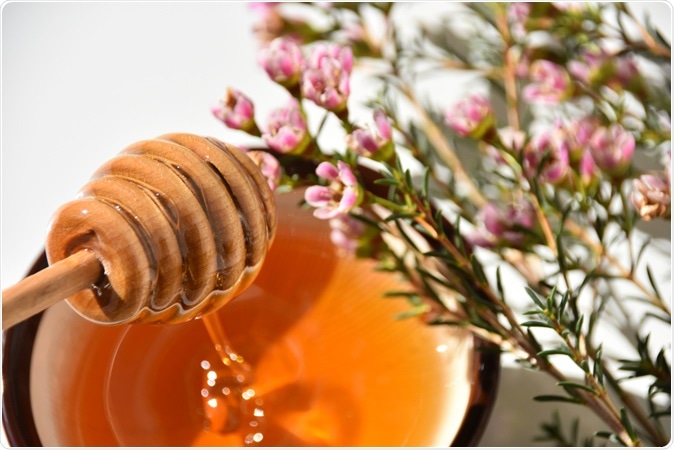And now, Manuka honey is proving a gamechanger in the fight against extremely drug-resistant infections, according to a new study published in the journal Frontiers.
Scientists say they have developed a way of sandwiching tiny amounts of Manuka honey between surgical mesh layers. Mesh encourages soft tissue healing after trauma or surgery by providing a stable surface for support. They are also used to provide excellent and durable support in a hernia repair. However, mesh is also prone to infection as the spaces allow bacteria to lodge and proliferate, spreading to develop a deadly biofilm over the mesh that is practically untreatable.
This means that post-surgical infections are more common in patients using mesh, which requires their repeated hospitalization and repeated courses of antibiotics. To make things worse, antibiotic resistance has made it even more difficult to treat such infections.

Manuka honey. Image Credit: Liga Cerina / Shutterstock
Manuka honey
Manuka honey is a very expensive honey from New Zealand, made by bees that feed on nectar from the wild Manuka tree (Leptospermum spp). This honey allegedly has even more antimicrobial properties than honey from elsewhere. Honey has been an age-old antibacterial dressing due to the content of hydrogen peroxide releasing chemicals. When hydrogen peroxide is removed, however, only Manuka honey continued to show antibacterial action among an array of different types of honey. Honey with similar activity has also been obtained from several Australian Leptospermum species.
Honey with high non-peroxide activity (NPA) is highly sought after as medical-grade honey, as it is not destroyed by the enzyme catalase in body fluids and is stable to sterilizing gamma irradiation. The antibacterial NPA of Manuka honey is due to the presence of the compound methylglyoxal (MGO), which forms from the compound dihydroxyacetone (DHA) present in nectar, and converted into MGO during the ripening of honey. The level of this molecule in Manuka honey is 100 or more times higher than in other types of honey.
MGO is actually a toxic compound, accelerating aging-related changes in collagen. However, in Manuka honey, it can work synergistically with other compounds to create a novel and powerful antibacterial effect that can help with wound healing without the use of antibiotics.
Other antibacterial compounds in this honey include flavonoids and aromatic acids. In vitro studies have shown that methicillin resistant Staphylococcus aureus (MRSA) laboratory cultures are inhibited by Manuka honey. The mechanism may involve the disruption of the synthesis of a protein called Fabl, that is essential to produce the fatty acids needed for the bacterial cell wall. Researchers have called for more studies to elucidate how exactly Manuka honey works so they can use it to provide treatment for MRSA infections and other antibiotic-resistant infections.
Honey and chronic wound healing
Many clinical trials have demonstrated the potential of honey to provide an alternative to current antibacterial treatments, especially with the rise of antibiotic resistance all over the world. With acute and chronic wounds, satisfactory healing is thought to occur with the use of medical-grade honey. However, high-quality trials are needed to confirm these preliminary findings.
The honey mesh sandwich
The researchers used nanotechnology to create a sandwich in which 8 layers each of negatively charged Manuka honey nanolayers and a positively charged polymer were interspersed on the surface of the mesh. Each layer was just 10-20 nm in thickness. The mesh was thus coated with an electrostatic nanocoating which prevents bacterial breeding for up to 3 weeks, due to the slow release of the honey.
Why the nanosized layers? The researchers say it is to control the rate of honey release. “Too little honey and it won’t be enough to fight the infection but too much honey can kill the cells,” according to them.
The meshes were then exposed to various common bacteria responsible for infections in the body, such as Staphylococcus, the resistant MRSA, and E. coli. They were proven to be compatible with biological tissues as well as providing protection against infection for up to 3 weeks – enough time, say the researchers, for the wound to heal well.
Implications
The scientists say this work shows how beneficial it can be to use honey in medical implants to prevent infection. Says researcher Piergorgio Gentile, “Honey has been used to treat infected wounds for thousands of years but this is the first time it has been shown to be effective at fighting infection in cells from inside the body.”
In contrast, earlier work aimed at creating similarly layered antibiotic-releasing coatings to protect implants against bacterial infection has been judged as failing to provide durable protection, as it could encourage the development of drug resistant bacterial strains.
Source:
Journal reference:
Mancuso Elena, Tonda-Turo Chiara, Ceresa Chiara, Pensabene Virginia, Connell Simon D., Fracchia Letizia, Gentile Piergiorgio Potential of Manuka Honey as a Natural Polyelectrolyte to Develop Biomimetic Nanostructured Meshes With Antimicrobial Properties Frontiers in Bioengineering and Biotechnology, DOI 10.3389/fbioe.2019.00344, https://www.frontiersin.org/article/10.3389/fbioe.2019.00344